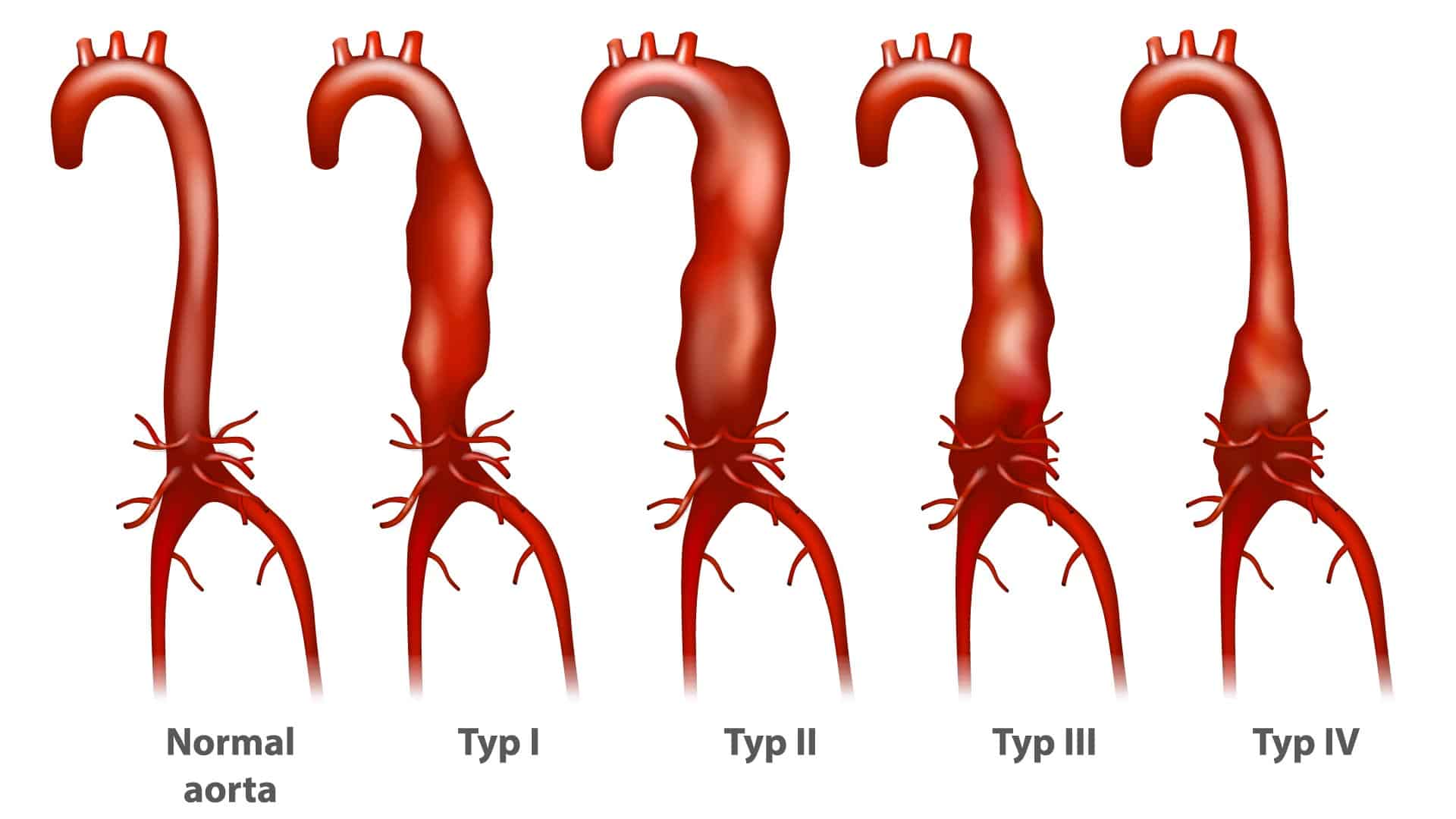- Take a medical history
- Perform a medical exam
- Seek medical records from previous doctors
- Computed tomography scan (also called a CT or CAT scan)
- Magnetic resonance imaging (MRI)
- Echocardiogram
- Transesophageal echocardiogram (TEE)
- Chest X-ray
- Arteriogram (angiogram)
- Aortic Ultrasound
Treatment for abdominal aortic disease varies widely depending on your exact diagnosis and symptoms. You may be advised to take a “watchful waiting” approach and make lifestyle changes such as:
- Smoking cessation, if you are a smoker
- Diet changes to focus on fruit, vegetables, whole grains, poultry, fish, and low-fat dairy
- Avoiding saturated fat, trans fat, and salt
- Managing blood pressure and cholesterol with medications
- Increasing exercise, as recommended by your doctor
If surgery is required, it will likely take one of two forms:
- Insertion of a vascular stent graft, which places a tube to support the artery wall
- Endovascular aneurysm repair, which repairs a bulge in the aorta to prevent bleeding/rupture
Certain risk factors make it more likely that you would be diagnosed with abdominal aortic disease. These include:
- Age over 60
- Having a family history of the disease
- Genetic factors
- High cholesterol
- High blood pressure
- Smoking
- Diabetes
- Obesity
This is a disease that is strongly linked with being male. Males are 4 to 5 times more likely to have it than females.
There are also certain disorders and genetic conditions that increase the risk of abdominal aortic disease, like Marfan syndrome, Ehlers-Danlos syndrome, Turner’s syndrome, polycystic kidney disease, bicuspid aortic valve, and coarctation of the aorta.
{,}show_first{:}{|}tab_name{:}When To See The Doctor{,}tab_content{:}Abdominal aortic disease usually has no outward symptoms, so it’s important to have an examination by a vascular specialist. Schedule a consultation with Maryland Vascular Specialists today, and we can provide the information you need to protect your health.
{,}show_first{:} )Abdominal Aortic Disease
The stomach, intestines, kidneys and other vital organs get oxygen from the arteries of the abdominal aorta. However, in abdominal aortic disease, damage occurs that prevents the normal oxygen flow.
Abdominal aortic disease can cause the aorta to split (dissection) or dilate (aneurysm). In either case, the results can be fatal. Here’s a closer look at the symptoms, causes, and risk factors for this disease, plus the treatments Maryland Vascular Specialists can provide.
Overview Of Abdominal Aortic Disease
The aorta helps blood flow throughout the body. With the help of the abdominal aortic arteries, the body’s organs are constantly replenished with fresh oxygen through the blood.
In abdominal aortic disease, the system is bogged down and doesn’t flow as it should. This may happen gradually over time, or it may happen all at once in a traumatic event. There is a strong genetic/family component to this disease, which can be compounded by certain lifestyle factors.
Symptoms
Most people with the abdominal aortic disease do not have any symptoms. This is why it is so important to have routine checkups.
In some cases, patients with the abdominal aortic disease may experience these symptoms:
- Abdominal pains or aching
- Sharp, stabbing feelings in the stomach
- Pain in and around the navel
- Lower back pain
- Low blood pressure
- Fast pulse
Causes
There are many contributors to the breakdown of the aortic wall. Atherosclerosis, or a buildup of fatty plaque and deposits, is thought to play an important role. It occurs when the arteries harden and the normal blood flow may be disrupted.
The primary conditions that contribute to abdominal aortic disease are:
- Atherosclerosis
- High blood pressure
- Genetic conditions
- Connective tissue disorders
- Injuries
To diagnose abdominal aortic disease your doctor at Maryland Vascular Specialists may order any of these tests and exams:
- Take a medical history
- Perform a medical exam
- Seek medical records from previous doctors
- Computed tomography scan (also called a CT or CAT scan)
- Magnetic resonance imaging (MRI)
- Echocardiogram
- Transesophageal echocardiogram (TEE)
- Chest X-ray
- Arteriogram (angiogram)
- Aortic Ultrasound
Treatment for abdominal aortic disease varies widely depending on your exact diagnosis and symptoms. You may be advised to take a “watchful waiting” approach and make lifestyle changes such as:
- Smoking cessation, if you are a smoker
- Diet changes to focus on fruit, vegetables, whole grains, poultry, fish, and low-fat dairy
- Avoiding saturated fat, trans fat, and salt
- Managing blood pressure and cholesterol with medications
- Increasing exercise, as recommended by your doctor
If surgery is required, it will likely take one of two forms:
- Insertion of a vascular stent graft, which places a tube to support the artery wall
- Endovascular aneurysm repair, which repairs a bulge in the aorta to prevent bleeding/rupture
Certain risk factors make it more likely that you would be diagnosed with abdominal aortic disease. These include:
- Age over 60
- Having a family history of the disease
- Genetic factors
- High cholesterol
- High blood pressure
- Smoking
- Diabetes
- Obesity
This is a disease that is strongly linked with being male. Males are 4 to 5 times more likely to have it than females.
There are also certain disorders and genetic conditions that increase the risk of abdominal aortic disease, like Marfan syndrome, Ehlers-Danlos syndrome, Turner’s syndrome, polycystic kidney disease, bicuspid aortic valve, and coarctation of the aorta.
Abdominal aortic disease usually has no outward symptoms, so it’s important to have an examination by a vascular specialist. Schedule a consultation with Maryland Vascular Specialists today, and we can provide the information you need to protect your health.
